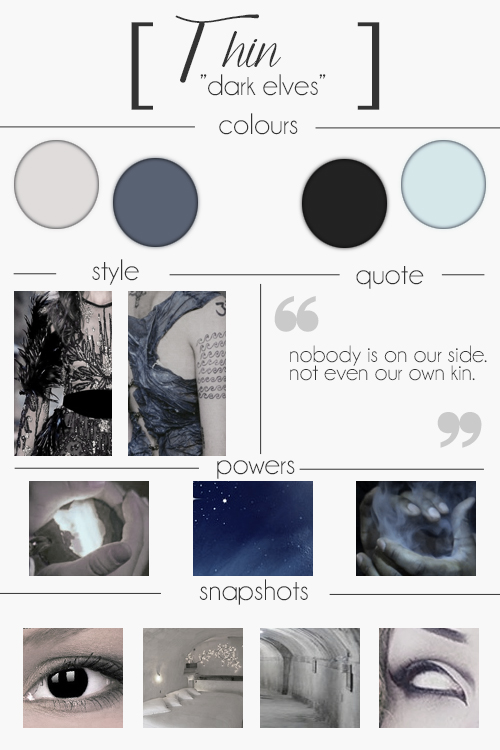Thin (Dark Elves)
Dwelling in underground places and generally keeping to themselves, the Thin (common name: Dark Elves) are perhaps the most mysterious and misunderstood of Elven races. They are powerful in moon, star and smoke-based magic, and have a natural affinity for night-dwelling creatures.
Though they officially have a seat in The Elven Council, the Dark Elves are considered ‘lesser’ forms of elf by many of their peers, thanks to their solitary and tightly-knit communities leading others to believe them aloof and arrogant, and their natural affinity for the dark leading others to be afraid of them.
Thanks to this, the Dark Elves have withdrawn themselves even more since the Uprising, choosing to live entirely separate from the surface world and the other Elven races except to trade and for major political meetings.
Basic Information
Anatomy
Dark Elves have sharp facial features, of which a strong, sharp jawline and longer faces are characteristic. Their eyes are often almond shaped and can be catlike or humanoid in appearence, often lacking an iris. Due to their life in mostly darkness, many Dark Elves are naturally blind, but those who can see have excellent night vision and often extremely light-sensitive. Their ears are long and often curved, and they generally have minimal hair, which is often pure white or black but can be shades of blue, dark greens or grey.
Thin who have reached puberty will have facial tattoos. These tattoos can come in all forms of religious markings, usually involving a series of lines, dots and swirls but some can be intricate patterns and decorations, usually in blue, black or white. These markings will glow in darkness and sometimes appear to shift or move with the use of their magic.
Biological Traits
Sex and Gender
Though the Thin are known to have both female and neuter genders, they are biologically identical and have no reproductive organs to speak of. Their genders are largely a construct learned from humans -- in early days of Thin culture a few elves picked up female/woman as a cultural role linked to the bearing and raising of children and over time it grew into a gender inextricably linked to the Thin's role in their settlement. Thin who task themselves with the primary raising of children or caretaking of the young will consider themselves female, though some may choose this gender based on gut feeling whether or not they actually grow to be caretakers.Sexuality
Though rare isolated examples exist of Thin who are interested in human interactions, the vast majority of Dark Elves are asexual. Their preference romantically is irrelevant unless they spend time outside of their homes which rarely happens, and thus is not a concept they have. Sexualities that exist widely within Thin culture are closest to what humans would deem Pansexual or else Aromantic, with little variation.Genetics and Reproduction
The Thin are creatures born of clay and magic, grown from the soil of their home and a piece of the parents' magic. When parents decide to have a child they will travel to the closest deposit of clay or mud blessed by the Priestess of the settlement to participate in the Ritual of Creation. This is a deeply involved ritual which involves offering a piece of each parent to the clay and crafting a baby from the material. The baby, if successfully crafted, will remain in clay form for around six months during which it will develop organs and humanoid features. If the baby has not developed a heartbeat by three months it will be considered a failed reproduction and returned respectfully to the ground.
Growth Rate & Stages
Thin babies tend to grow from their clay forms into a humanoid form after around 6 months, at which point they resemble a 25 week old fetus and have not yet opened their eyes, but are able to move and breathe and have limbs in proportion to what we would consider a humanoid form. After around a year the baby will be able to open its eyes and lift its head unaided.
Dietary Needs and Habits
As the Thin live primarily underground, their main food source comes from mushrooms and roots they can cultivate or scavenge in underground farming systems, and leafy plants that can survive without sunlight. Their cuisine, therefore, is primarily formed of soups and stews that can be made and boiled without relying on high quality plant material. In some settlements systems are introduced wherein root vegetables are planted and harvested from below -- with the soil packed into systems that hold the soil in place, so that the vegetables can grow and leaf above ground.
Civilization and Culture
Naming Traditions
Dark elves are named after the god they are closest to -- eg, a priestess could be named "nii del (female patron she's closest to/speaks for)" and a common enby would be "nii del (patron of enbies)".
Nii del roughly meaning "child belonging to". Dark Elves do not generally receive these names until after their first coming-of-age ritual, when they reach the age of puberty and begin their journey into adulthood. Before this their name suffix is nii del Thain, meaning "child belonging to the Ancestors".
Major Organizations
The Dark Elves live in five major constituencies: the Northern (primarily Scandinavia), Eastern (primarily Asia and Russia ) Southern (Southern Europe and Africa), Western (the Americas) and Central (Europe). There are smaller groups and sub-groups of Dark Elves around the world, but they tend to follow the beliefs of either their closest constituency, or their own niche and independent beliefs.
Major Language Groups and Dialects
The official language of Dark Elves is Sinithin. This is an umbrella term that covers the major and minor dialects of all locations, which of course have many differences.
One of the main constants of Sinithin is plural pronouns. Due to the heavy intertwining of personal self and spiritual self, the Thin do not refer to themselves and each other with singular pronouns (I, me, etc) but instead include their Gods, making every pronoun plural (we, us, our, etc).
Common Dress Code
Due to their limited resources and trading options, Dark Elf fashion is usually in tatters, but some have access to the materials for capes and armour. The richest thing they wear is generally jewellery made with precious metals mined from their caves. They generally don face paints and tattoos that glow in the dim light of their cities, and own more weaponry than other elves.
Culture and Cultural Heritage
Each constituency has their own group of Gods. There is some overlap, but most are unique to their locale's needs. Every constituency has its own patron of genderless elves and patron of female elves.
History
Dark Elves have been around for as long as any other fae: borne from the places where the sun rarely touches. Living in small, close-knit groups, it wasn't until the Thin capital of Norway that the people saw the beginnings of an organised society. In the hostile environments, many Thin had to band together to survive -- until, eventually, they were driven from their home by the constantly changing climate, forced to journey to every corner of the continent in search of better shelter.
The largest settlements found safety in underground homes, building homes for themselves and eventually growing to become the largest cities in Thin culture. Others found smaller shelters in remote areas.




Comments